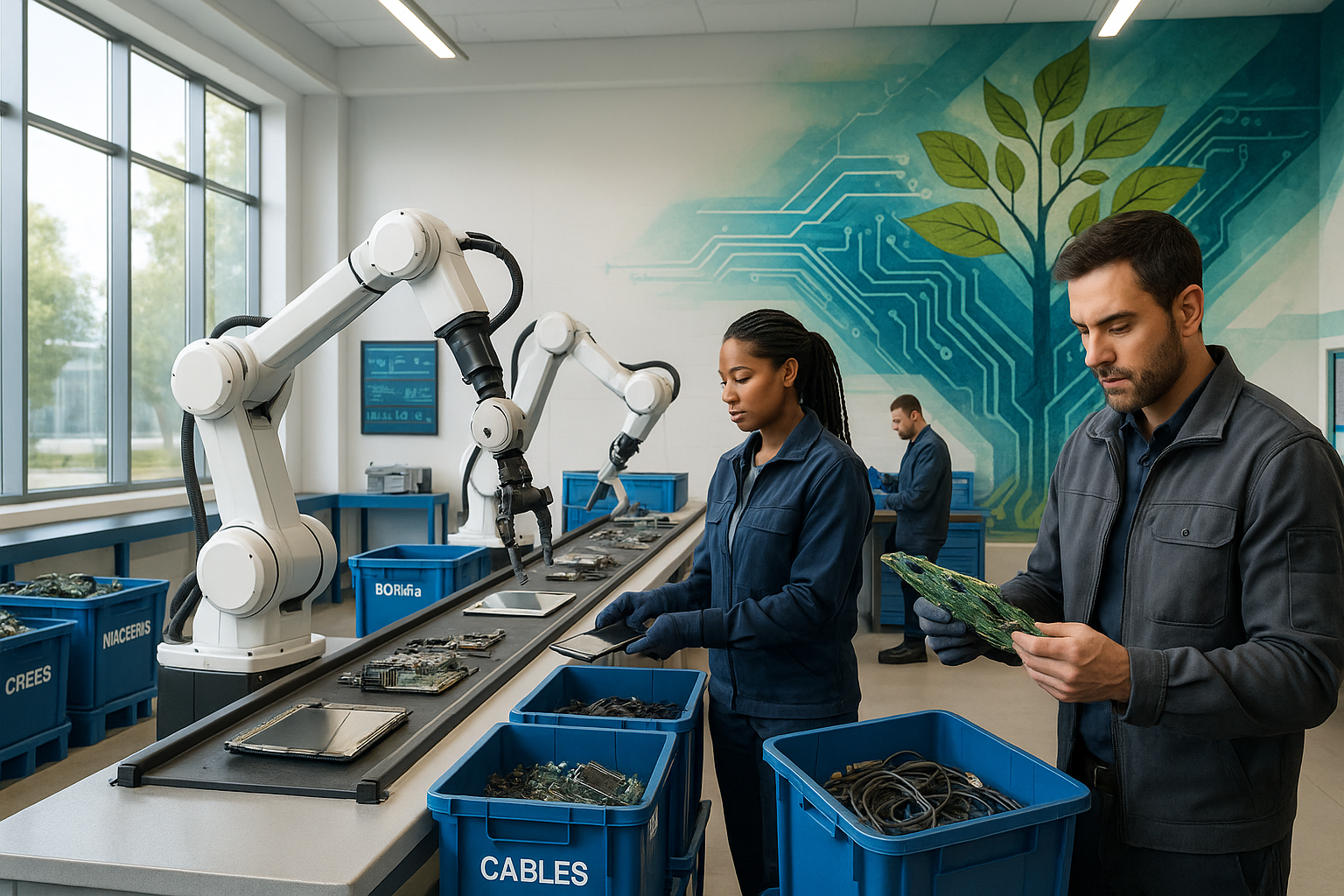That’s equivalent to nearly 4,500 Eiffel Towers! 😲 From the smartphone in your pocket to the laptop on your desk, these devices eventually outlive their usefulness and become waste. But what happens to all this discarded technology?
In this article, we will delve into the topic of Reclaim, Recycle, Reimagine: The Future of E-Waste Disposal. As our lives become increasingly digital, the issue of e-waste management is more pressing than ever. We’ll unpack the challenges and opportunities in e-waste disposal, and explore the innovative solutions being developed to address this global issue.🌍
Throughout this article, we’ll explore the current state of e-waste disposal and the issues plaguing this sector. We’ll discuss the alarming rate of e-waste production and the environmental impact of improper disposal. We’ll also shine a light on the hidden potential of e-waste and the vast amount of valuable metals it contains – a literal gold mine waiting to be tapped.💰
Next, we’ll dive deep into the recycling process, uncovering the technologies and processes employed to recover valuable materials from e-waste. You’ll learn about the different stages of e-waste recycling, from collection and transportation to dismantling and material recovery. You might be surprised to find out just how much can be reclaimed from your old electronic devices!📱
Moving forward, we will reimagine the future of e-waste disposal. We’ll take a look at the innovative strategies being implemented around the world to promote sustainable disposal and recycling practices. From cutting-edge technologies to community-based initiatives, you’ll discover a range of promising solutions that are reshaping the e-waste landscape.🔄
Finally, we’ll explore the role you can play in this e-waste revolution. After all, the change starts with each one of us. We’ll provide you with practical tips on how you can reduce, reuse, and recycle your electronic devices, and help build a more sustainable future. 🌱
Whether you’re a tech enthusiast, environmental advocate, or simply someone concerned about the future of our planet, this article promises to be an enlightening read. So buckle up, and get ready for a deep dive into the fascinating world of e-waste disposal!
Remember, as we navigate through this journey of understanding e-waste disposal, it’s crucial to understand that we all have a part to play. Each device we dispose of correctly, every piece of technology we recycle, brings us a step closer to a sustainable future. Let’s embark on this journey together. 🤝
🌎 Reclaim, Recycle, Reimagine: The Unseen Potential of E-Waste
Every second, our planet is bombarded with a torrent of e-waste. From obsolete smartphones to outdated laptops, e-waste is rapidly becoming a significant issue in our digital age. The problem with e-waste disposal is multifaceted, encompassing environmental degradation, health risks, and resource depletion. However, with every challenge comes an opportunity, and e-waste disposal is no exception. Reclaiming, recycling, and reimagining e-waste can lead to sustainable practices that not only help protect our planet but also drive innovation.
In this in-depth discussion, we will dive into the world of e-waste disposal, understand its implications and explore innovative solutions. We will also look at how reclaiming precious materials from e-waste can drive the circular economy, and the role of technology in facilitating this shift.
📊 Understanding the Scale of E-Waste
To fully comprehend the magnitude of the e-waste problem, we must first understand its scale. In 2019 alone, the world generated a staggering 53.6 million metric tons of e-waste, according to the Global E-waste Monitor. This figure is projected to increase by 21% by 2030, making e-waste the fastest-growing waste stream globally.
Despite these alarming numbers, only 17.4% of e-waste was collected and recycled in 2019. The rest ended up in landfills, incinerated, or illegally dumped, posing severe environmental and health risks.
Here is a comparative table that clearly illustrates the magnitude of the e-waste problem.
| Year | E-waste Generated (million metric tons) | E-waste Recycled (million metric tons) |
|---|---|---|
| 2015 | 44.7 | 7.7 |
| 2016 | 46.1 | 8.9 |
| 2017 | 48.5 | 9.3 |
| 2018 | 50.2 | 10.1 |
| 2019 | 53.6 | 9.3 |
💎 Reclaiming Precious Resources from E-Waste
E-waste is not just trash; it’s a gold mine. Literally. E-waste contains precious metals such as gold, silver, copper, and palladium, which can be reclaimed and reused. For instance, one ton of mobile phones can yield up to 350 grams of gold, which is far more than what is extracted from one ton of gold ore. Moreover, the process of extracting these precious metals from e-waste is less environmentally damaging than traditional mining.
But it’s not just about metals. E-waste also contains valuable non-metallic materials, including high-quality plastics, glass, and ceramics, which can be recycled and reused. The key is to have effective and efficient recycling processes in place that can separate these materials from e-waste.
To get a clearer understanding of the potential of e-waste recycling, check out the video below titled “The Story of E-Waste: What happens to tech once it’s trash” by the YouTube channel Verge Science.
♻️ The Role of Technology in E-Waste Recycling
Technology is both a problem and a solution when it comes to e-waste. On the one hand, the rapid advancement of technology is driving the surge in e-waste. On the other hand, technology can provide innovative solutions to address the e-waste problem.
From robotic sorting systems that can accurately separate different types of materials from e-waste, to hydrometallurgical processes that use aqueous chemistry to recover precious metals, technology is playing a pivotal role in e-waste recycling.
But technology alone is not enough. We also need supportive policies, increased consumer awareness, and a shift in corporate behavior to move towards a circular economy where resources are not just consumed but are also reclaimed, recycled, and reused.
🚀 Reimagining the Future of E-Waste Disposal
The future of e-waste disposal lies in reimagining waste not as a problem, but as a resource. By shifting our perspective, we can turn the e-waste problem into an opportunity for sustainable development.
Imagine a world where your old smartphone is not just discarded but is disassembled, its precious metals are extracted and used to make new products, its plastic parts are recycled into 3D printing filament, and its glass is reused in construction materials. This is not a futuristic vision; it’s a reality that is slowly taking shape as we begin to realize the potential of e-waste.
The journey to a sustainable e-waste future is not without challenges. But by embracing innovation, pushing for regulatory reforms, and fostering consumer awareness, we can turn these challenges into opportunities. Let’s reclaim, recycle, and reimagine e-waste for a sustainable future.

Conclusion
Having dissected the intricate aspects of software engineering, I believe we have thoroughly immersed ourselves into the profundities of this fascinating field. As we navigated through the various principles, methodologies, and tools associated with this discipline, I hope you now appreciate the value of software engineering not only in creating robust, scalable, and efficient software systems, but also in providing a structured approach to problem-solving.
From the onset, we underscored the importance of the Software Development Life Cycle (SDLC) and the pivotal role it plays in the systematic development of software. I trust the detailed discussions on the different SDLC models like Waterfall, Agile, Iterative, and Spiral, have highlighted their unique characteristics, advantages, and possible limitations. This understanding is crucial in determining which model is best suited for a particular project.
The article also addressed key methodologies including Scrum, Extreme Programming (XP), and Lean Software Development. In this context, we explored how these methodologies could enhance productivity, boost team collaboration, and ultimately yield high-quality software. I hope this has reinforced the idea that the choice of methodology has significant implications on the project outcome.
We also tackled software testing – a critical stage in software development. We examined the different types of testing, including unit testing, integration testing, and system testing, and explored the various tools available for each. The emphasis on the significance of each testing phase, and the potential pitfalls if overlooked, should underscore the crucial role of testing in assuring the quality and reliability of software.
In all these discussions, our aim was to unravel the complexities of software engineering and distill them into comprehensible concepts. The field of software engineering is indeed complex, but it is this complexity that makes it so intriguing, so challenging, and so rewarding. Therefore, I encourage you to delve deeper, explore further, and keep asking questions.
The technology landscape is continuously evolving, and as software engineers, we have the privilege and responsibility to shape this landscape. So, let us apply what we have learned and continue to expand our knowledge.
Feel free to share your thoughts, experiences, or queries in the comment section below. I am looking forward to your insights and engaging in enriching discussions. You can also share this article within your network, to spread the knowledge and inspire others.
Remember, knowledge is power, but sharing knowledge empowers.🌐🚀
Stay curious, stay inspired, and keep learning!
For further reading, I recommend the following resources:
ACM Digital Library – A collection of publications by the Association for Computing Machinery, including journals, conference proceedings, and magazines on various areas of computing.
IEEE Xplore Digital Library – Provides access to technical literature in electrical engineering, computer science, and electronics published by the Institute of Electrical and Electronics Engineers.
References:
1. ScienceDirect – A full-text scientific database offering journal articles and book chapters from more than 2,500 peer-reviewed journals and more than 11,000 books.
2. Springer – One of the leading international scientific publishing companies, publishing over 2,200 journals and more than 8,500 new books a year, covering a wide range of subjects including science, technology, medicine, humanities and law.
Happy reading! 📚💻



